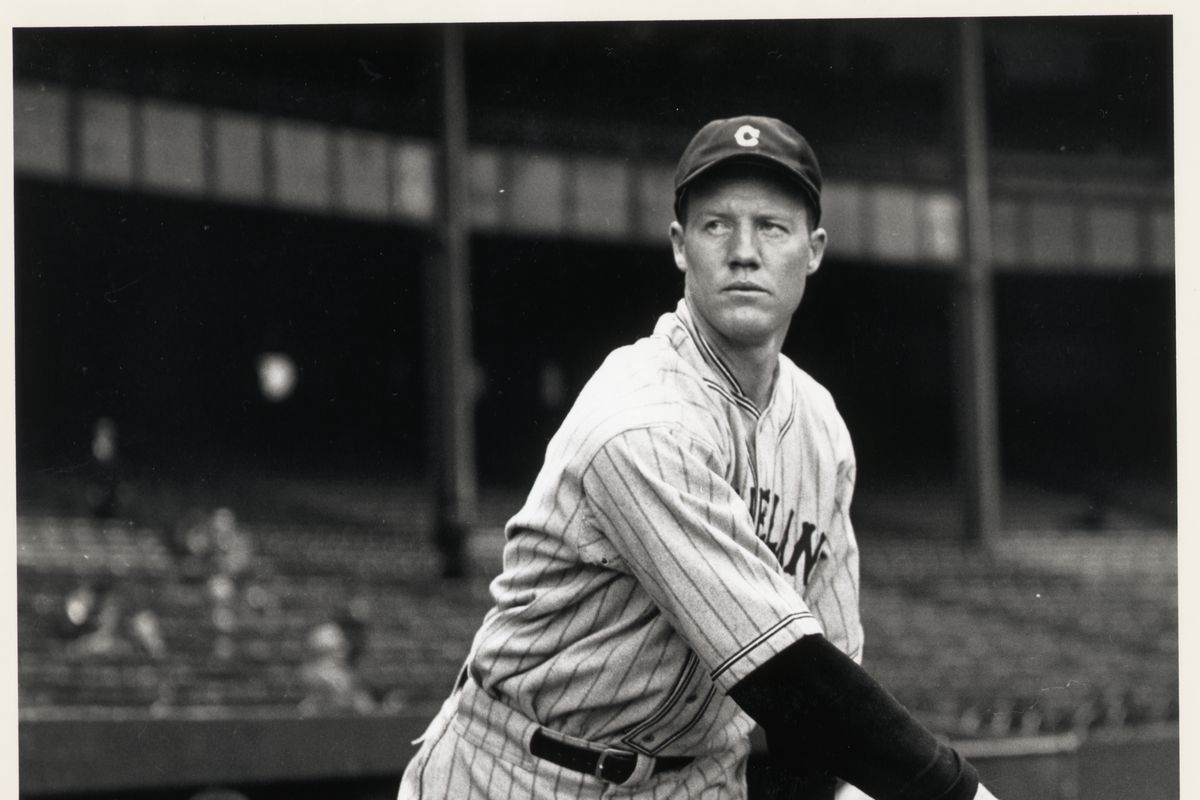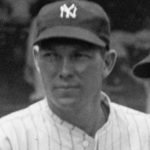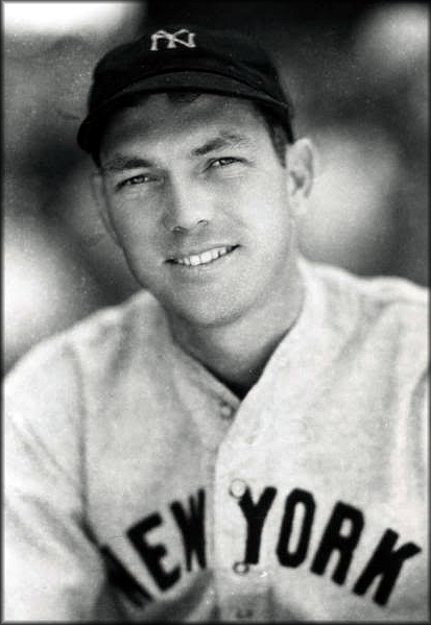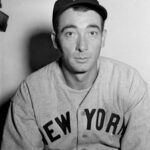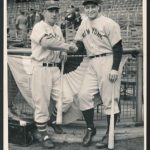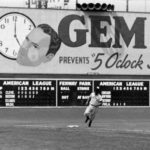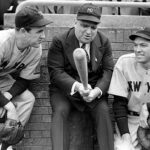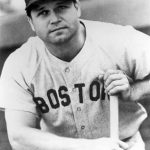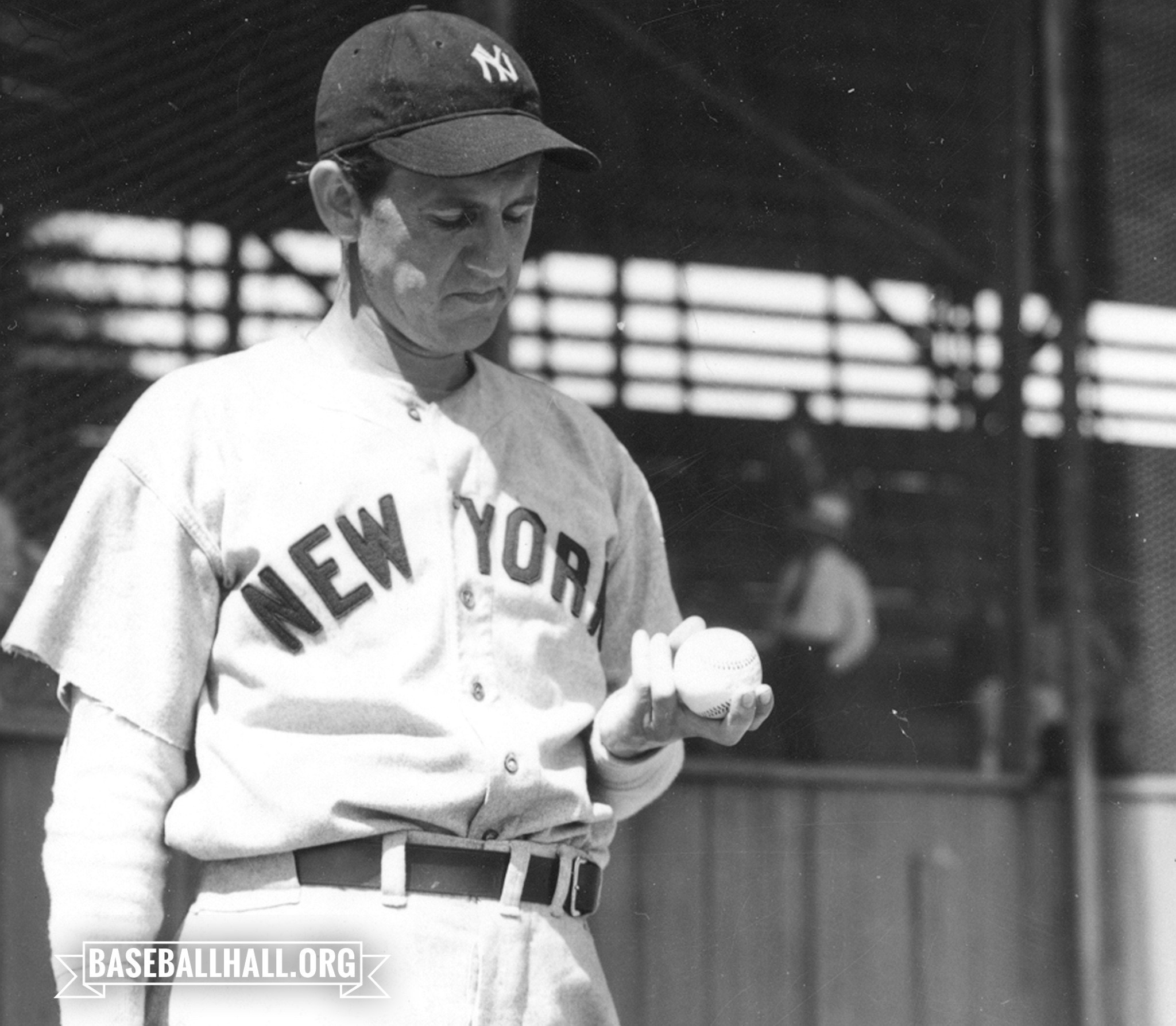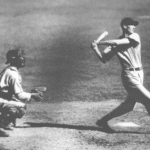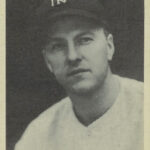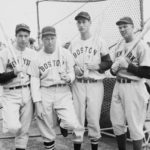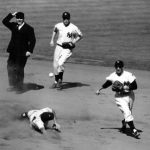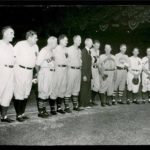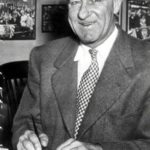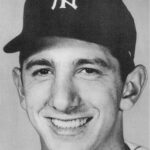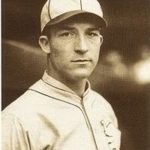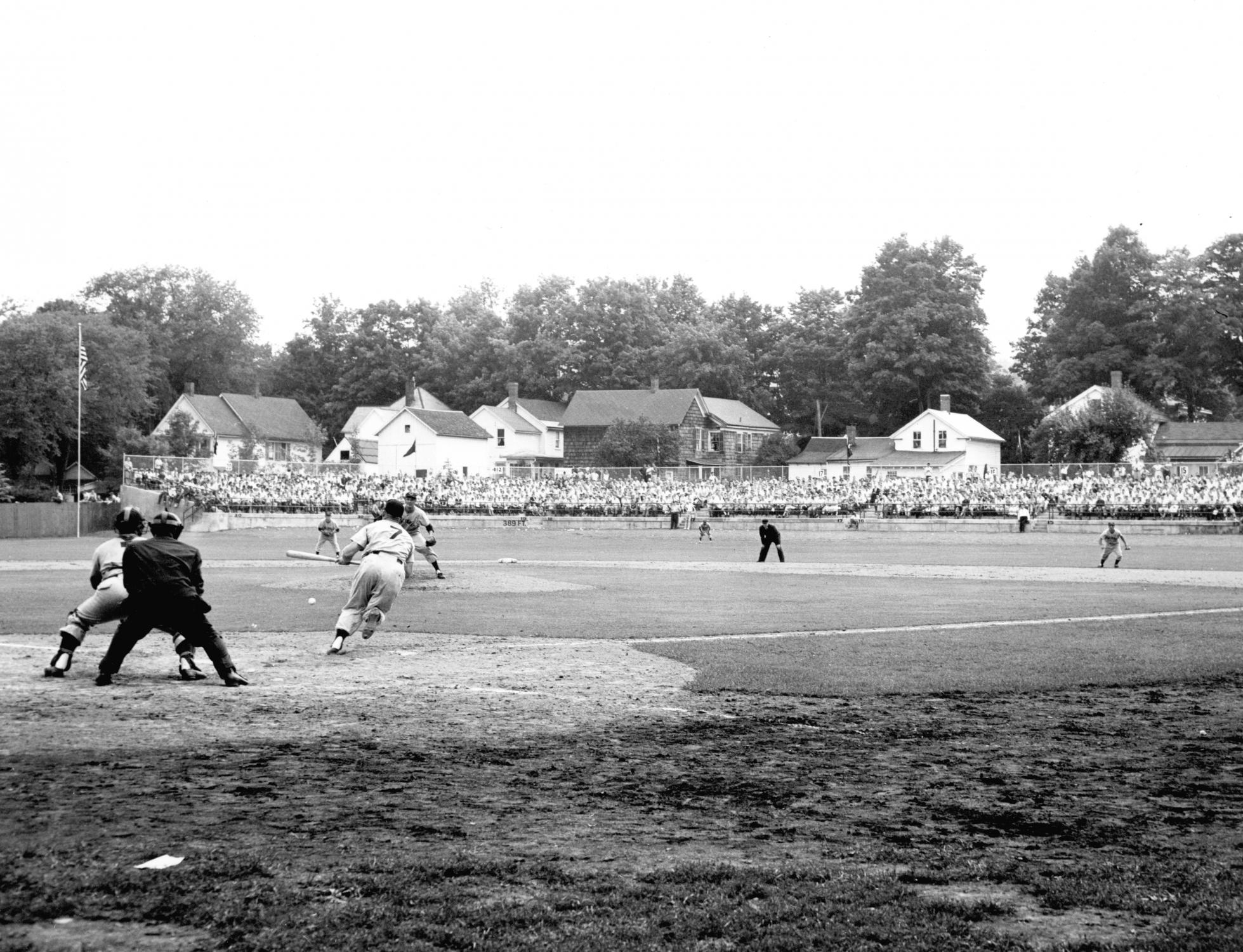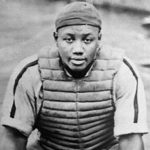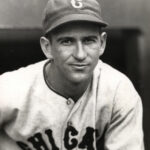Bill Dickey Stats & Facts
Bill Dickey
Position: Catcher
Bats: Left • Throws: Right
6-1, 185lb (185cm, 83kg)
Born: June 6, 1907 in Bastrop, LA us
Died: November 12, 1993 in Little Rock, AR
Buried: Roselawn Memorial Park, Little Rock, AR
High School: Searcy HS (Searcy, AR)
Debut: August 15, 1928 (6,767th in major league history)
vs. CHW 2 AB, 0 H, 0 HR, 0 RBI, 0 SB
Last Game: September 8, 1946
vs. WSH 1 AB, 1 H, 0 HR, 0 RBI, 0 SB
Hall of Fame: Inducted as Player in 1954. (Voted by BBWAA on 202/252 ballots)
View Bill Dickey’s Page at the Baseball Hall of Fame (plaque, photos, videos).
Full Name: William Malcolm Dickey
Nicknames: The Man Nobody Knows
View Player Info from the B-R Bullpen
View Player Bio from the SABR BioProject
Relatives: Brother of George Dickey
Nine Players Who Debuted in 1928
Al Lopez
Bill Dickey
Chuck Klein
Rollie Hemsley
Pepper Martin
Mel Harder
Carl Hubbell
George Earnshaw
Clint Brown
The Bill Dickey Teammate Team
C: Yogi Berra
1B: Lou Gehrig
2B: Tony Lazzeri
3B: Red Rolfe
SS: Frankie Crosetti
LF: Tommy Henrich
CF: Joe DiMaggio
RF: Babe Ruth
SP: Lefty Gomez
SP: Waite Hoyt
SP: Red Ruffing
SP: Spud Chandler
RP: Johnny Murphy
M: Joe McCarthy
Notable Events and Chronology for Bill Dickey Career
Bill Dickey
The first in a long line of outstanding catchers in New York Yankees history, Bill Dickey likely would be better-remembered today had he not been replaced almost immediately by Yogi Berra after he retired at the conclusion of the 1946 season. Dickey also had the misfortune of spending his entire career being overshadowed by other Yankee greats such as Babe Ruth, Lou Gehrig, and Joe DiMaggio. Nevertheless, Dickey, who was both an outstanding hitter and an exceptional defensive receiver, must not be overlooked since he rivaled Mickey Cochrane as the Major Leagues premier catcher of the first half of the 20th century.
Biography
Born in Bastrop, Louisiana on June 6, 1907, William Malcolm Dickey made his major league debut with the Yankees during the latter stages of the 1928 campaign, appearing in 10 games and batting just .200 in his 15 plate appearances. The lanky, 6’1″, 195-pounder became the team’s starting catcher the following year, beginning a record-string of 13 consecutive seasons in which he appeared in at least 100 games behind the plate. Dickey batted .324 in his first full season, before compiling averages of .339 and .327 in 1930 and 1931, respectively.
Although Dickey posted impressive batting averages in each of his first three seasons, he exhibited little in the way of power, combining for a total of only 21 home runs. However, he began to establish himself as a more integral part of New York’s offense in 1932, when he reached new career highs in home runs (15) and runs batted in (84), while also surpassing the .300-mark in batting for the fourth of six consecutive times. Dickey earned his first of six nominations to The Sporting News All-Star Team, then celebrated by batting .438, with four runs batted in, against the Cubs during New York’s four-game sweep of the National League pennant-winners in the World Series.
Dickey had another outstanding season in 1933, driving in 97 runs, batting .318, and appearing in major league baseball’s inaugural All-Star Game. Injuries cut into Dickey’s playing time and offensive production in each of the next two seasons, but he still managed to catch more than 100 games each year, combining for 26 homers and 153 RBIs, and earning his second All-Star Game nomination in 1934. During 1934’s Mid-Summer Classic, it was Dickey who ended Carl Hubbell’s strikeout string, following whiffs by Babe Ruth, Lou Gehrig, Jimmie Foxx, Al Simmons, and Joe Cronin with a single to centerfield.
Healthy again in 1936, Dickey began a string of four consecutive seasons that were the most productive of his career. In helping the Yankees capture four consecutive world championships, he surpassed 20 home runs and 100 RBIs each year, while also batting well over .300 each season. Dickey hit 22 homers, knocked in 107 runs, scored 99 others, and batted a career-high .362 in 1936. His .362 batting average was the highest single-season mark ever posted by a catcher (tied by Mike Piazza of Los Angeles in 1997), until Joe Mauer hit .365 for Minnesota in 2009. Dickey placed fifth in the league MVP voting at season’s end. He finished fifth in the balloting again the following year, when he batted .332, scored 87 runs, and established new career highs with 29 homers and 133 runs batted in. Dickey continued to excel in each of the next two seasons, hitting 27 home runs and knocking in 115 runs in 1938, and hitting 24 long balls, driving in 105 runs, and scoring 98 others in 1939. He placed second to Jimmie Foxx in the league MVP voting in 1938, before punctuating his great season by batting .400 against the Cubs during New York’s four-game sweep of Chicago in the World Series.
Dickey never again posted huge offensive numbers, but he remained the finest defensive receiver in the game until he retired. Known for his strong throwing arm, his ability to handle a pitching staff, and his signal-calling ability, Dickey was, in many ways, the heart and soul of the Yankee dynasty of the late-1930s.
Bill Werber was a backup infielder on the Yankees for two seasons, before serving as starting third baseman for four different teams over the course of the next ten years. Werber later discussed the impression Dickey made on him during his two years in New York: “Bill Dickey was the heart of the team defensively and commanded tremendous respect from the Yankee pitchers. Once the game started, he ran the show.”
Dickey also earned the respect of his opponents around the league, albeit in a totally different fashion. Although he was known mostly for his quiet demeanor off the field, Dickey occasionally displayed the same fiery temperament on the diamond that helped lead the Yankees to eight pennants and seven world championships in his 16 years with the team. Dickey’s temper became apparent for all to see on July 4, 1932 at Washington’s Griffith Stadium, when he fractured the jaw of Washington outfielder Carl Reynolds with one punch following a collision at home plate. The incident resulted in a $1,000 fine and a one-month suspension for Dickey.
Known also for his close friendship with Lou Gehrig, Dickey was seen by many as the Yankees’ new leader on the field after their captain was stricken with the fatal illness that eventually came to bear his name.
After seeing his role behind the plate gradually diminish from 1941 to 1943, Dickey spent two years in the Navy during World War II. He returned to the Yankees in 1946, appearing in 54 games before taking over the managerial reins from Joe McCarthy at mid-season. Dickey resigned at the end of the year, but he came back to New York as a coach under Casey Stengel from 1949 to 1957. Dickey served primarily as first base coach and as special catching instructor to Yogi Berra, who later credited his tutor with turning him into a solid defensive receiver.
Dickey was inducted into the Hall of Fame in 1954, and he later shared a joint ceremony with Berra at Yankee Stadium when the team retired their famous number 8 jersey. Dickey passed away in Little Rock, Arkansas on November 12, 1993, at the age of 86.
Bill Dickey ended his career with 202 home runs, 1,209 runs batted in, 930 runs scored, and a .313 batting average. In addition to surpassing 20 homers and 100 runs batted in four times each, he scored more than 90 runs twice and batted over .300 a total of 11 times. Dickey appeared in 11 All-Star Games and finished in the top 10 in the league MVP voting on five separate occasions. Considered to be the finest defensive receiver of his time, Dickey posted a lifetime .988 fielding percentage and held the records for putouts and fielding average by a catcher at the time of his retirement.
Perhaps Dickey’s greatest contributions to the Yankees, though, could not be measured by his statistics. He was a tremendous team leader who impacted the game in any number of ways. An admiring sportswriter named Dan Daniel once wrote: “Dickey isn’t just a catcher. He’s a ball club. He isn’t just a player. He’s an influence.”
@ET-DC@eyJkeW5hbWljIjp0cnVlLCJjb250ZW50IjoicG9zdF90YWdzIiwic2V0dGluZ3MiOnsiYmVmb3JlIjoiTGVhcm4gTW9yZSBhYm91dCB0aGUgdGVhbXMsIHBsYXllcnMsIGJhbGwgcGFya3MgYW5kIGV2ZW50cyB0aGF0IGhhcHBlbmVkIG9uIHRoaXMgZGF0ZSBpbiBoaXN0b3J5IC0gLSAtIC0gLSAtIC0gIiwiYWZ0ZXIiOiIiLCJsaW5rX3RvX3Rlcm1fcGFnZSI6Im9uIiwic2VwYXJhdG9yIjoiIHwgIiwiY2F0ZWdvcnlfdHlwZSI6InBvc3RfdGFnIn19@
Factoids, Quotes, Milestones and Odd Facts
Played For
New York Yankees (1928-1946)
Managed
New York Yankees (1946)
Dickey was the second of three Yankee managers in the 1946 season, and led the team to a 57-48 record.
Similar: Gabby Hartnett and Mickey Cochrane, though both were probably better players than Dickey.
Linked: Carl Reynolds, Ben Chapman, Yogi Berra
Best Season, 1936
Dickey batted .362 with a career-high .617 slugging percentage in just 112 games, and his hitting helped re-establish the Yankee dynasty, which hadn’t won a pennant in four years. The keen Dickey struck out just 16 times. Whereas Dickey’s power seemed to stem from the short right field line at Yankee Stadium, that did not mean that he hit poorly on the road. In ’36 for example, he batted .351 in 51 home games with 14 homers and 52 RBI. In 61 road contests he batted .371 with 8 home runs and 55 RBI. He had more extra-base hits per 100 at-bats on the road than he did in the Bronx (13.8 to 12.5). Historically, however, Dickey had more power in Yankee Stadium.
Post-Season Appearances
1932 World Series
1936 World Series
1937 World Series
1938 World Series
1939 World Series
1941 World Series
1942 World Series
1943 World Series
Description
“As an all-around catcher for both hitting and catching, I’d have to rate Bill Dickey of the Yankees in the 1930’s and 40’s as the best I ever saw,” said Bob Feller, “He was as good as anyone behind the plate, and better with the bat. There were several others I’d include right behind Dickey: Al Lopez, Mickey Cochrane, Gabby Gartnett, Roy Campanella and Wes Westrum. Yogi Berra? An excellent hitter, especially in the late innings with the game hanging in the balance, and the American League’s Most Valuable Player three times, but as a catcher I always thought he was above average.”
Factoid
In 1931, Bill Dickey became the first catcher to play an entire season without allowing a single passed ball.
Feats: On July 26, 1939, Dickey belted three home runs at Yankee Stadium.
Quotes About Dickey
“Bill Dickey was the heart of the team defensively and commanded tremendous respect from the Yankee pitchers. Once the game started, he ran the show.” — Bill Werber
Home Run Facts
Highest % of home runs hit in home park (min. 200 career):
Bill Dickey… 66.8%
Bob Horner… 65.1%
Bobby Doerr… 65.0%
Rico Carty… 64.7%
Cy Williams… 64.1%
Rico Petrocelli… 63.8%
Chuck Klein… 63.3%
Ron Santo… 63.1%
Mel Ott… 63.1%
Hank Greenberg… 61.9%
Earl Averill… 60.5%
Dolph Camilli… 60.2%
All-Star Selections
1933 AL
1934 AL
1936 AL
1937 AL
1938 AL
1939 AL
1940 AL
1941 AL
1942 AL
1943 AL
1946 AL
Replaced
Johnny Grabowski and Pat Collins, who had teamed in a platoon arrangement for the Yankees in 1927 and 1928.
Replaced By
Aaron Robinson in 1946-1947, and then Yogi Berra, who wore Dickey’s #8, which was ultimately retired in honor of both catchers.
Best Strength as a Player
Pulling the ball.
Largest Weakness as a Player
Early in his career, Dickey was an impatient hitter, and he was also a below-average baserunner.
Other Resources & Links



